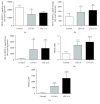Multiorgan Development of Oxidative and Nitrosative Stress in LPS-Induced Endotoxemia in C57Bl/6 Mice: DHE-Based In Vivo Approach
- PMID: 31249650
- PMCID: PMC6556324
- DOI: 10.1155/2019/7838406
Multiorgan Development of Oxidative and Nitrosative Stress in LPS-Induced Endotoxemia in C57Bl/6 Mice: DHE-Based In Vivo Approach
Abstract
Detection of free radicals in tissues is challenging. Most approaches rely on incubating excised sections or homogenates with reagents, typically at supraphysiologic oxygen tensions, to finally detect surrogate, nonspecific end products. In the present work, we explored the potential of using intravenously (i.v.) injected dihydroethidine (DHE) to detect superoxide radical (O2 ∙-) abundance in vivo by quantification of the superoxide-specific DHE oxidation product, 2-hydroxyethidium (2-OH-E+), as well as ethidium (E+) and DHE in multiple tissues in a murine model of endotoxemia induced by lipopolysaccharide (LPS). LPS was injected intraperitoneally (i.p.), while DHE was delivered via the tail vein one hour before sacrifice. Tissues (kidney, lung, liver, and brain) were harvested and subjected to HPLC/fluorescent analysis of DHE and its monomeric oxidation products. In parallel, electron spin resonance (EPR) spin trapping was used to measure nitric oxide (∙NO) production in the aorta, lung, and liver isolated from the same mice. Endotoxemic inflammation was validated by analysis of plasma biomarkers. The concentration of 2-OH-E+ varied in the liver, lung, and kidney; however, the ratios of 2-OH-E+/E+ and 2-OH-E+/DHE were increased in the liver and kidney but not in the lung or the brain. An LPS-induced robust level of ∙NO burst was observed in the liver, whereas the lung demonstrated a moderate yet progressive increase in the rate of ∙NO production. Interestingly, endothelial dysfunction was observed in the aorta, as evidenced by decreased ∙NO production 6 hours post-LPS injection that coincided with the inflammatory burden of endotoxemia (e.g. elevated serum amyloid A and prostaglandin E2). Combined, these data demonstrate that systemic delivery of DHE affords the capacity to specifically detect O2 ∙- production in vivo. Furthermore, the ratio of 2-OH-E+/E+ oxidation products in tissues provides a tool for comparative insight into the oxidative environments in various organs. Based on our findings, we demonstrate that the endotoxemic liver is susceptible to both O2 ∙--mediated and nonspecific oxidant stress as well as nitrosative stress. Oxidant stress in the lung was detected to a lesser extent, thus underscoring a differential response of liver and lung to endotoxemic injury induced by intraperitoneal LPS injection.
Figures





Similar articles
-
H2S Attenuates LPS-Induced Acute Lung Injury by Reducing Oxidative/Nitrative Stress and Inflammation.Cell Physiol Biochem. 2016;40(6):1603-1612. doi: 10.1159/000453210. Epub 2016 Dec 23. Cell Physiol Biochem. 2016. PMID: 28006762
-
Role of nitric oxide in hepatic ischemia-reperfusion with endotoxemia.J Inflamm. 1995-1996;46(3):144-54. J Inflamm. 1995. PMID: 8844495
-
Superoxide radical formation in diverse organs of rats with experimentally induced obstructive jaundice.Redox Rep. 2008;13(4):179-84. doi: 10.1179/135100008X308902. Redox Rep. 2008. PMID: 18647488
-
Nitrosative Stress and Its Association with Cardiometabolic Disorders.Molecules. 2020 May 31;25(11):2555. doi: 10.3390/molecules25112555. Molecules. 2020. PMID: 32486343 Free PMC article. Review.
-
HPLC-based monitoring of products formed from hydroethidine-based fluorogenic probes--the ultimate approach for intra- and extracellular superoxide detection.Biochim Biophys Acta. 2014 Feb;1840(2):739-44. doi: 10.1016/j.bbagen.2013.05.008. Epub 2013 May 10. Biochim Biophys Acta. 2014. PMID: 23668959 Free PMC article. Review.
Cited by
-
Itaconate Suppresses the Activation of Mitochondrial NLRP3 Inflammasome and Oxidative Stress in Allergic Airway Inflammation.Antioxidants (Basel). 2023 Feb 15;12(2):489. doi: 10.3390/antiox12020489. Antioxidants (Basel). 2023. PMID: 36830047 Free PMC article.
-
Use of Electron Paramagnetic Resonance (EPR) to Evaluate Redox Status in a Preclinical Model of Acute Lung Injury.Mol Imaging Biol. 2024 Jun;26(3):495-502. doi: 10.1007/s11307-023-01826-5. Epub 2023 May 16. Mol Imaging Biol. 2024. PMID: 37193807 Free PMC article.
-
Mapping the Multi-Organ miRNA-mRNA Regulatory Network in LPS-Mediated Endotoxemic Mice: Exploring the Shared Underlying Key Genes and Mechanisms.Front Mol Biosci. 2020 Nov 24;7:573327. doi: 10.3389/fmolb.2020.573327. eCollection 2020. Front Mol Biosci. 2020. PMID: 33330617 Free PMC article.
-
Resolvin D5 (RvD5) Reduces Renal Damage Caused by LPS Endotoxemia in Female Mice.Molecules. 2022 Dec 23;28(1):121. doi: 10.3390/molecules28010121. Molecules. 2022. PMID: 36615318 Free PMC article.
-
Systemic Administration of Insulin Receptor Antagonist Results in Endothelial and Perivascular Adipose Tissue Dysfunction in Mice.Cells. 2021 Jun 9;10(6):1448. doi: 10.3390/cells10061448. Cells. 2021. PMID: 34207844 Free PMC article.
References
-
- Fink B., Laude K., McCann L., Doughan A., Harrison D. G., Dikalov S. Detection of intracellular superoxide formation in endothelial cells and intact tissues using dihydroethidium and an HPLC-based assay. American Journal of Physiology-Cell Physiology. 2004;287(4):C895–C902. doi: 10.1152/ajpcell.00028.2004. - DOI - PubMed
MeSH terms
Substances
LinkOut - more resources
Full Text Sources

